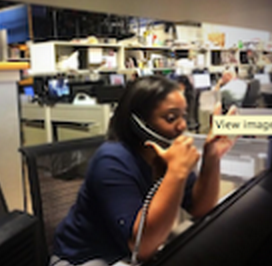Since Saturday, local media in St. Louis have covered the shooting of Michael Brown in Ferguson, Missouri. National media joined them, and on Friday, the story made the front pages of newspapers in the U.S. and around the world. We checked in with several newsroom leaders and asked them the same five questions about their work, the competition and the best and worst of what they’ve seen. This is part three in our series.
Joe Lamie is managing editor of KTVI. Audrey Prywitch is a news director. Susan Brubaker is an executive producer. They answered these questions together for Poynter via email.
1. What is the most important thing you’ve told your staff as they cover this story?
Stay safe. Cover the story. Now is not the time for advocacy journalism. Our role is observer. Don’t incite. Let the story tell itself.
2. Give us an example of the best coverage you’ve produced or seen.
Rioting and tear gas. Brave crews of ours who used new technology and unmarked cars to blend into the community and bring incredible pictures.
3. What’s the worst?
Competitor’s very youthful reporter who didn’t understand the moment as tear gas was fired and made her live report only about herself. How afraid she was. How the police treated her. How she felt fear. The story is about the people, not the reporter. We’ve used some good veteran presence who aren’t intimidated by this kind of story.
4. Do you see a difference in national and local coverage of this story?
Absolutely. National coverage has used so-called pundits, who go on the air and question police tactics, protestors motives, why looting wasn’t stopped, etc. National coverage has shown a real disconnect from understanding the story because they aren’t here. Local coverage has focused on the communities, its people, and its leaders. It’s been about the story … not the perception nationally of the story.
Web and TV producers in the @FOX2now newsroom working the #Ferguson story via @jmillitzer pictured: @msvera pic.twitter.com/JLOQ35NyYb
— FOX2now (@FOX2now) August 14, 2014
5. How does our ability to report in real time across platforms help citizens — and have you seen downsides that must be managed?
Questions about whether real time reporting incites more to join… and whether or not it puts police lives in jeopardy. Social media also makes it difficult to stay in front of the story. That’s a whole other issue.
The single biggest thing I’ve learned from this is how Twitter broke every aspect of the story before any legitimate mainstream media. We must adapt, and cover the story via Twitter as well as our live feeds. It’s the only way to combat bad civilian reporting… with trained media reporting. Tweet.
Previously: Margaret Wolf Freivogel, editor of St. Louis Public Radio; Chris King, editorial director of The St. Louis American
Correction: An earlier version of this story cited these answers to Joe Lamie. They also came from Audrey Prywitch and Susan Brubaker. Due to an editor’s mistake, Brubaker was also identified as a director. She’s a producer.








